The Lagoon Nebula is a vast emission nebula located approximately 4,100 light-years away in the constellation Sagittarius. With an apparent magnitude of 4.6 and an apparent size of 90 by 40 arcminutes, the nebula is one of the most popular targets for amateur astronomers. It is listed as Messier 8 (M8) in the Messier catalogue and has the designation NGC 6523 in the New General Catalogue. The large interstellar cloud is also catalogued as Sharpless 25, Gum 72, and RCW 146.
The Lagoon Nebula is one of only two star-forming regions that are visible to the unaided eye for observers in the mid-northern latitudes. (The other one is the brighter Orion Nebula in the constellation Orion.) With an apparent magnitude of 4.6, the Lagoon may be spotted in a dark field of the Milky Way’s bright band in exceptionally good conditions. It lies in the direction of the Galactic centre.
The Lagoon Nebula has a physical size of 110 by 50 light-years and is composed mainly of hydrogen. It is classified as an H II region, a molecular cloud of partially ionized hydrogen where new stars are forming.
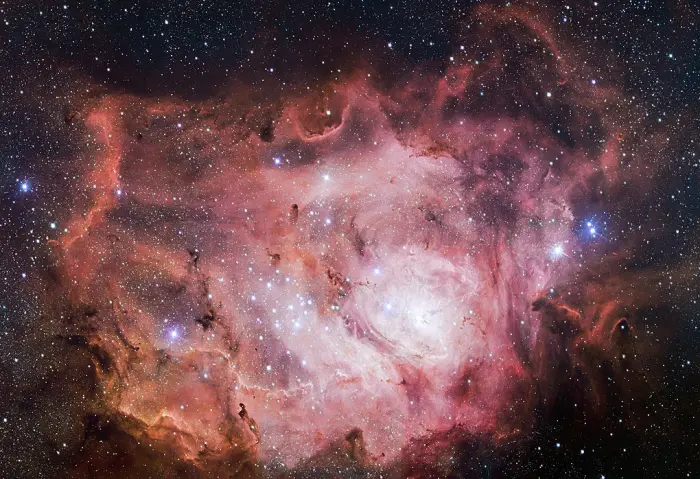
The VLT Survey Telescope (VST) at ESO’s Paranal Observatory in Chile has captured this richly detailed new image of the Lagoon Nebula. This giant cloud of gas and dust is creating intensely bright young stars, and is home to young stellar clusters. Image credit: ESO/VPHAS+ team (CC BY 4.0)
The star-forming region contains the young open cluster NGC 6530 (Collinder 362). The loose cluster has an estimated age of only 4 – 6 million years and lies approximately 4,320 light-years away. It has a radius of 7 light-years and an apparent size of 14 arcminutes. It appears in the eastern part of the Lagoon.
The brightest stars of NGC 6530 shine at magnitude 6.9 and fainter. They are visible in 10×50 binoculars. Larger binoculars reveal around 15 members of the cluster, while small telescopes resolve more than two dozen stars.
The cluster contains a total of 3,675 candidate members, of which 2,728 are likely members. Some of these are T Tauri stars, young stars that have not yet developed to the main sequence stage. Like the Christmas Tree Cluster in the constellation Monoceros (the Unicorn), which has a similar spectral distribution, NGC 6530 is among the youngest open clusters known.
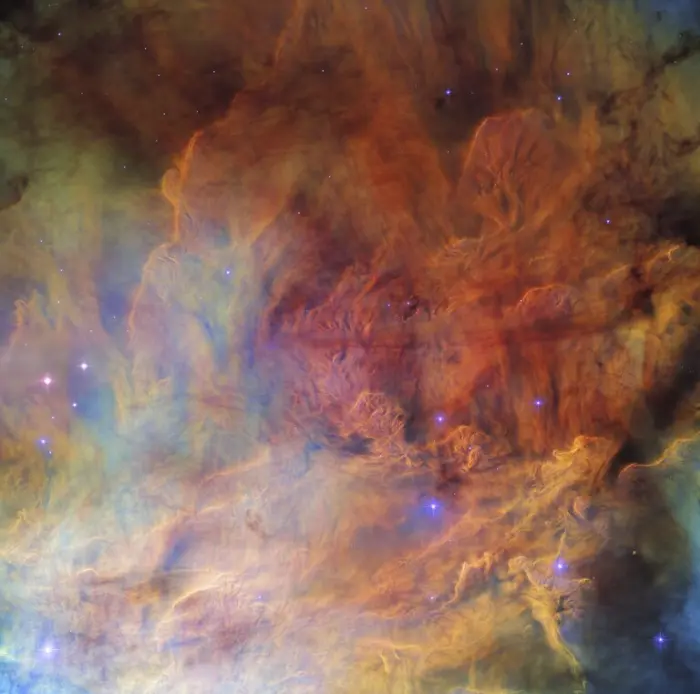
A portion of the open cluster NGC 6530 appears as a roiling wall of smoke studded with stars in this image from the NASA/ESA Hubble Space Telescope. NGC 6530 is a collection of several thousand stars lying around 4350 light-years from Earth in the constellation Sagittarius. The cluster is set within the larger Lagoon Nebula, a gigantic interstellar cloud of gas and dust. It is the nebula that gives this image its distinctly smokey appearance; clouds of interstellar gas and dust stretch from one side of this image to the other. Astronomers investigated NGC 6530 using Hubble’s Advanced Camera for Surveys and Wide Field Planetary Camera 2. They scoured the region in the hope of finding new examples of proplyds, a particular class of illuminated protoplanetary discs surrounding newborn stars. The vast majority of proplyds have been found in only one region, the nearby Orion Nebula. This makes understanding their origin and lifetimes in other astronomical environments challenging. Image credit: ESA/Hubble & NASA, ESO, O. De Marco Acknowledgement: M. H. Özsaraç (CC BY 4.0)
The central condensation in the Lagoon Nebula is known as the Hourglass Nebula. Named by British astronomer John Herschel, who discovered it, the Hourglass Nebula is the brightest portion of the Lagoon. It occupies an area of about 30 arcseconds. Like the rest of the larger nebula, it is a star-forming region. It shares its name with the Hourglass Nebula (or Engraved Hourglass Nebula, MyCn 18) in the constellation Musca (the Fly).
The Hourglass region in M8 contains a radio source, which was first detected by the National Radio Astronomy Observatory (NRAO) in Green Bank, West Virginia, in 1973.
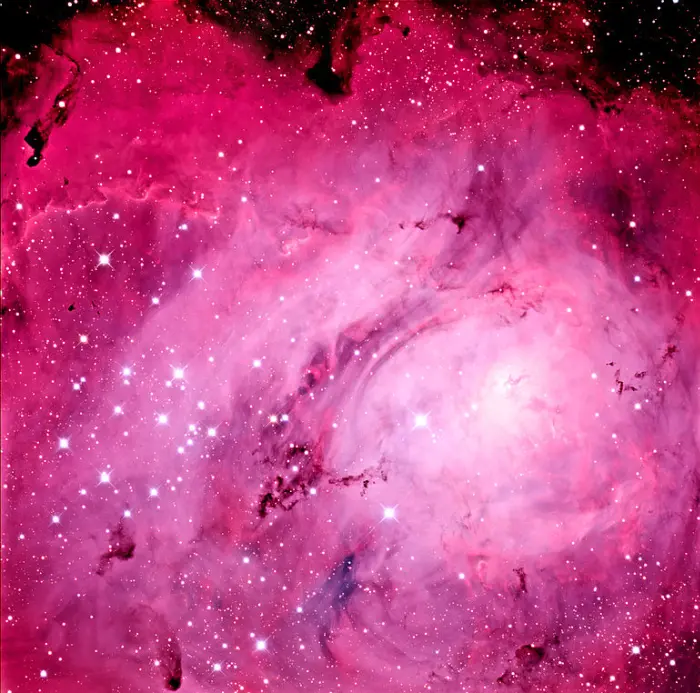
Hourglass Nebula region of Messier 8 (M8) in the 32 inch Schulman telescope on Mt. Lemmon, AZ. Image credit: Wikimedia Commons/Jschulman555 (CC BY-SA 4.0)
The Lagoon Nebula was named for the lagoon-shaped dark lane that appears above the bright Hourglass region. Irish astronomer and author Agnes M. Clerke may have been the first to use the name Lagoon in her 1890 book The System of Stars. The dark lane divides the nebula in half. It crosses the brighter region of nebulosity from the northeast to the southwest.
One of the stars ionizing the Lagoon Nebula is Herschel 36, which lies near the nebula’s centre. Herschel 36 is a very hot young star of the spectral type O7. It illuminates the dense Hourglass Nebula and some of the surrounding region. The star has an apparent magnitude of 9.5. It has 32 times the Sun’s mass and is about 200,000 times more luminous. It has an estimated age of only 1 million years and a surface temperature of around 20,000 K.
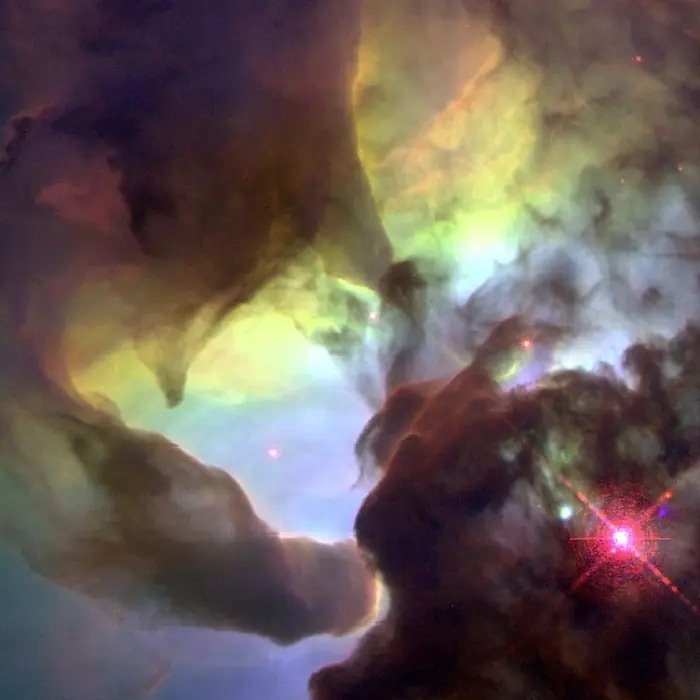
This NASA Hubble Space Telescope (HST) image reveals a pair of one-half light-year long interstellar “twisters,” eerie funnels and twisted-rope structures in the heart of the Lagoon Nebula (Messier 8). The central hot O-type star Herschel 36 (lower right), is the primary source of the ionizing radiation for the brightest region in the nebula, called the Hourglass. These color-coded images are the combination of individual exposures taken in July and September, 1995 with Hubble’s Wide Field and Planetary Camera 2 (WFPC2) through three narrow-band filters (red light ionized sulphur atoms, blue light, double ionized oxygen atoms, green light, ionized hydrogen). Image credit: NASA, A.Caulet St-ECF, ESA
The brightest star associated with the Lagoon Nebula is 9 Sagittarii, a massive binary system composed of two hot, luminous O-type main sequence stars. The star system has an apparent magnitude of 5.97 and is theoretically visible to the unaided eye. Like Herschel 36, it lies near the centre of the Lagoon Nebula, close to the open cluster NGC 6530. The system is believed to be a member of the cluster. It is the main source of ionization for the surrounding nebulosity. It has a combined spectrum of O4V.
The components of 9 Sgr have masses 32.1 and 18.9 times that of the Sun and luminosities of 479,000 and 224,000 Suns respectively. Both stars are supernova candidates. Even though they are only around 1 million years old, it will not be long (astronomically speaking) before they reach the end of their life cycles due to their high mass.
The system has an orbital period of 3,261 ± 69 days (9 years). This is the longest known period for a pair of O-type stars. The two stars have an eccentric orbit and the physical separation between them varies from 11 to 27 astronomical units (Earth-Sun distances). The system was discovered to be a binary in 2012 by an international team of astronomers led by G. Rauw of the Université de Liège in Belgium.
9 Sagittarii is surrounded by an H II region about 30 light-years across. The region lies in front of a denser star-forming region and includes the reflection nebulae NGC 6523 and NGC 6533. The Hourglass region appears 3 arcminutes west-southwest of 9 Sgr.
The region that faintly extends toward the east of the Lagoon Nebula has its own Index Catalogue number, IC 4678. IC 4678 is an emission nebula around 25 light-years across. It lies approximately 5,000 light-years away. Its light is partially blocked by a dark absorption nebula. A small reflection nebula appears in the same area.
Like other H II regions, the Lagoon Nebula contains many Bok globules. These are collapsing dark protostellar clouds about 10,000 AU (astronomical units) in diameter. The small patches of dark nebulosity contain dense dust and gas from which protostars form. Bok globules typically give birth to binary and multiple star systems.
The three most prominent Bok globules inside the Lagoon were catalogued by American astronomer E.E. Barnard as Barnard 88 (B88), Barnard 89 (B89), and Barnard 296 (B296) in his catalogue of dark nebulae (Barnard Catalogue of Dark Markings in the Sky, 1919).
Messier 8 also contains a structure that resembles a tornado or funnel. The structure is shaped by intense ultraviolet light coming from a hot O-type star that heats and ionizes gases on the nebula’s surface.
Messier 8 is one of the brightest known regions undergoing intense star forming activity. Four Herbig-Haro objects – bright patches of nebulosity within which new stars form – were discovered in the nebula in 2006. The discovery provided first direct evidence of active star formation within the Lagoon.
The 2006 study was led by J. I. Arias of the Universidad Nacional de La Plata in Argentina. The team studied the Lagoon using infrared photometry and detected evidence for low- and intermediate-mass pre-main sequence stars in the nebula.
The Lagoon Nebula has already formed the young star cluster NGC 6530. It will continue to form stars until it runs out of gas, which will take at least hundreds of thousands of years and maybe even millions of years.
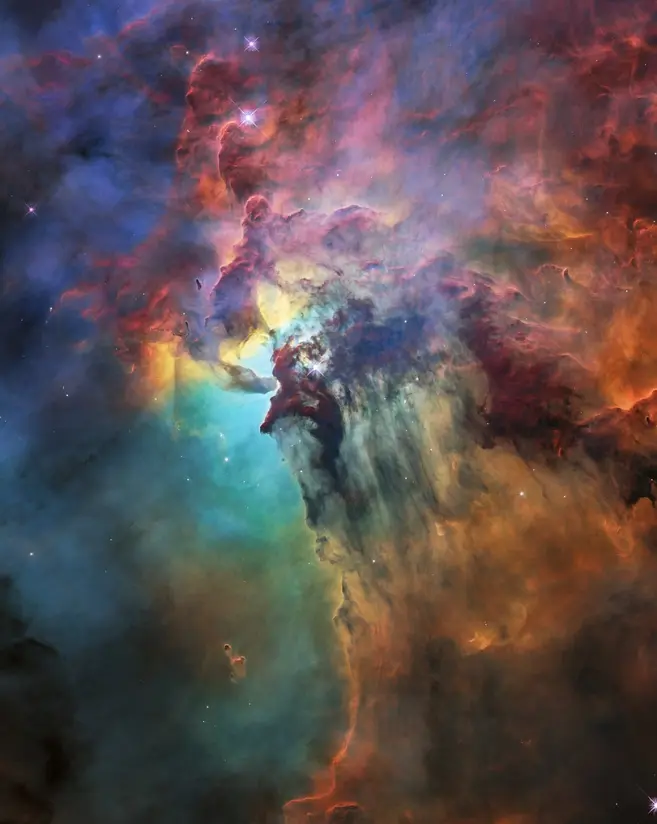
To celebrate its 28th anniversary in space the NASA/ESA Hubble Space Telescope took this amazing and colourful image of the Lagoon Nebula. The whole nebula, about 4000 light-years away, is an incredible 55 light-years wide and 20 light-years tall. This image shows only a small part of this turbulent star-formation region, about four light-years across. This stunning nebula was first catalogued in 1654 by the Italian astronomer Giovanni Battista Hodierna, who sought to record nebulous objects in the night sky so they would not be mistaken for comets. Since Hodierna’s observations, the Lagoon Nebula has been photographed and analysed by many telescopes and astronomers all over the world. The observations were taken by Hubble’s Wide Field Camera 3 between 12 February and 18 February 2018. Image credit: NASA, ESA, STScI
Facts
The Lagoon Nebula was discovered by Italian astronomer Giovanni Battista Hodierna from Sicily before 1654. It was independently discovered by French astronomer Guillaume Le Gentil in 1747.
When Le Gentil observed the nebula, he noted, “The first [nebula] is between the left heel of Serpentarius [Ophiuchus] and the bow of Sagittarius, to the west of a star cluster which is located in this place in the sky, and which appears the same at eyesight, rather resembling the nebula of Cancer [Messier 44, also known as Praesepe or the Beehive Cluster]: That nebula has exactly the shape of an equilateral triangle, a bit elongated, and the turning point to the south-west. I have observed it with a refractor of 18 to 20 feet [FL], and it always appeared to me nebulous and transparent; it touches with its base a rather beautiful star, seen in the refractor, and which is the brightest of all those which compose the star cluster I have mentioned. The right ascension of this star is for the beginning of 1748, 266d 44′ 22” [17h 46m 57s], its southern declination, 25d 8′ 10”, its [ecliptical] longitude, 26d 45′ 00”, and its southern [ecliptical] latitude 1d 30′ 00”.”
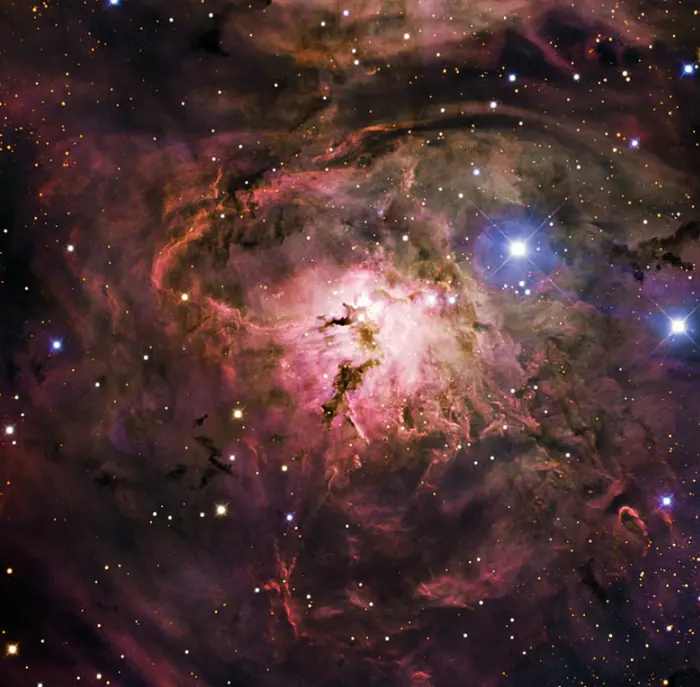
Gas and dust condense, beginning the process of creating new stars in this image of Messier 8, also known as the Lagoon Nebula. Located four to five thousand light-years away, in the constellation of Sagittarius (the Archer), the nebula is a giant interstellar cloud, one hundred light-years across. It boasts many large, hot stars, whose ultraviolet radiation sculpts the gas and dust into unusual shapes. Two of these giant stars illuminate the brightest part of the nebula, known as the Hourglass Nebula, a spiralling, funnel-like shape near its centre. Messier 8 is one of the few star-forming nebulae visible to the unaided eye, and was discovered as long ago as 1747, although the full range of colours wasn’t visible until the advent of more powerful telescopes. The Lagoon Nebula derives its name from the wide lagoon-shaped dark lane located in the middle of the nebula that divides it into two glowing sections. Image: ESO/IDA/Danish 1.5 m/ R. Gendler, U.G. Jørgensen, K. Harpsøe
French astronomer and comet hunter Charles Messier observed the nebula on May 23 to 24, 1764 and later noted, “I also have determined, in the same night [May 23-24, 1764], the position of a small star cluster which one sees in the form of a nebula, if one views it with an ordinary [non-achromatic] refractor of 3 feet [FL], but when employing a good instrument one notices a large quantity of small stars: near this cluster is a rather brilliant star which is surrounded by a very faint light: this is the ninth star of Sagittarius, of seventh magnitude, according to the catalog of Flamsteed: this cluster appears in an elongated shape which extends from North-East to South-West. I observed its position during its passage of the Meridian, comparing it with the star Delta Sagittarii, and I determined its right ascension as 267d 29′ 30”, and its declination as 24d 21′ 10” south. This star cluster could have an extension, from North-East to South-West, of about 30 minutes of arc.”
English astronomer John Flamsteed independently observed the object and documented it as a nebula around 1680, giving it the designation Number 2446 in his catalogue.
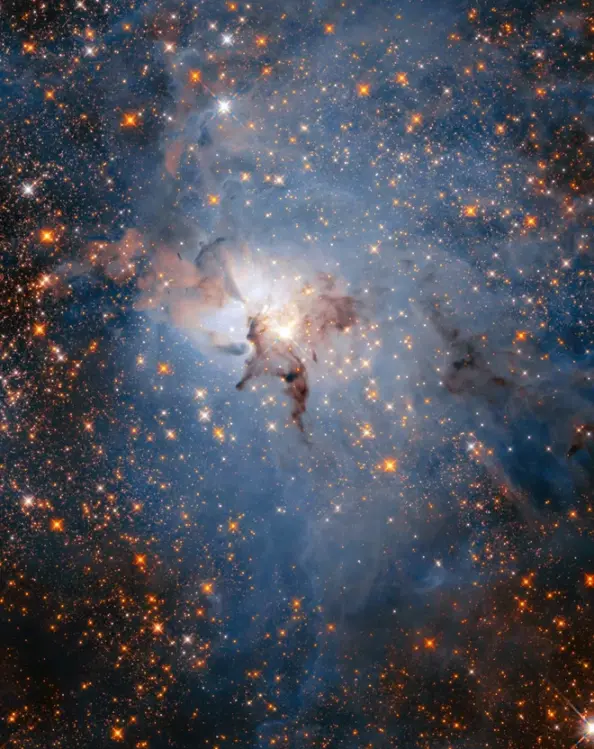
Hubble’s 28th-anniversary picture depicts a group of stars hidden behind clouds of dust and gas. The Lagoon Nebula located approximately 4,000 light-years away from Earth in the constellation Sagittarius. It is visible to the unaided eye in dark-sky sites. Credit: NASA/ESA (the Hubble Space Telescope)
The Lagoon Nebula is the brightest and largest of the several prominent nebulae in Sagittarius. Visually, it has a diameter about three times that of the full Moon.
When observed with binoculars, Messier 8 has an oblong shape, with the Hourglass Nebula lying on one side and separated by a dark rift from the open cluster of stars that lie on the other side.
The neighbouring region is home to several notable deep sky objects, including the Trifid Nebula (Messier 20), which lies about half a degree north of Messier 8, and the open cluster Messier 21. Two globular clusters can be seen slightly to the southeast, NGC 6544 and NGC 6553.
The Lagoon and Trifid nebulae appear in the same wide field of view and are a popular astrophotography target. They may be part of a larger complex of nebulosity, which also includes the nebulae NGC 6559 and IC 4681. The four nebulae appear to be connected by a thin veil of dust and gas.
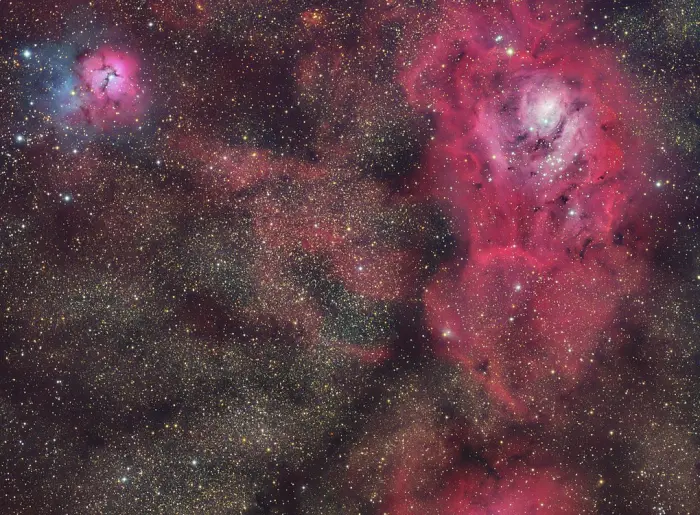
The Lagoon and Trifid nebulae, image credit: Wikimedia Commons/Ivan Bok (CC BY 4.0)
Location
The Lagoon Nebula appears near the Teapot asterism in Sagittarius and can be found using the bright stars that form the right side of the Teapot. A line extended from Kaus Australis (Epsilon Sagittarii), the brightest star in Sagittarius, through the midpoint of the imaginary line connecting Kaus Media (Delta Sagittarii) and Alnasl (Gamma2 Sagittarii), leads to the Lagoon and Trifid nebulae.
In binoculars, the Lagoon Nebula appears as a cloudy patch with a defined core. The open cluster NGC 6530 easily stands out, but the surrounding nebulosity is best observed with O III filters. Visually, the nebula appears gray, while long-exposure photos reveal a pink colour.
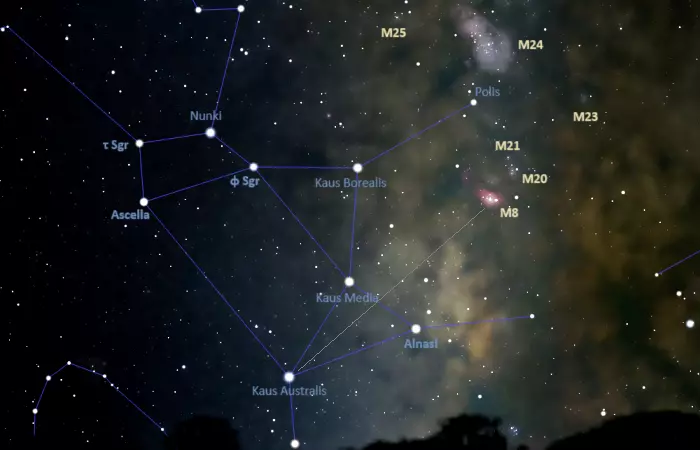
The location of the Lagoon Nebula (Messier 8), image: Stellarium
When seen through a telescope of any size, the open cluster is easily resolved and some of the details of the nebula can be seen. Telescopes with a large aperture will also reveal the dark nebula in good viewing conditions. The Lagoon is best observed at low magnification because it is an exceptionally large object.
The best time of the year to observe the Lagoon Nebula from the northern hemisphere is from mid-summer to mid-fall. For observers in the mid-northern latitudes, the nebula always appears above the southern horizon, slightly above the right side of the Teapot.
Due to its location in the southern sky, the Lagoon Nebula is much easier to observe from the southern hemisphere, where it climbs much higher in the sky. It is best seen during the month of August, when the constellation Sagittarius is prominent in the evening sky.
Lagoon Nebula – Messier 8
| Constellation | Sagittarius |
| Right ascension | 18h 03m 37.0s |
| Declination | −24° 23′ 12″ |
| Apparent magnitude | 4.6 |
| Apparent size | 90 x 40 arcminutes |
| Distance | 4,100 light-years (1,250 parsecs) |
| Radius | 55 by 20 light-years |
| Names and designations | Lagoon Nebula, Messier 8, M8, NGC 6523, Sharpless 25, Sh2-25, Gum 72, W 29, RCW 146, CTB 46, LBN 25, LBN 006.06-01.23, NRL 11, Mol 37, GRS G006.20 -01.20, PMN J1803-2422, Kes 58, OCISM 1, MM 10, LMH 11 |
Images
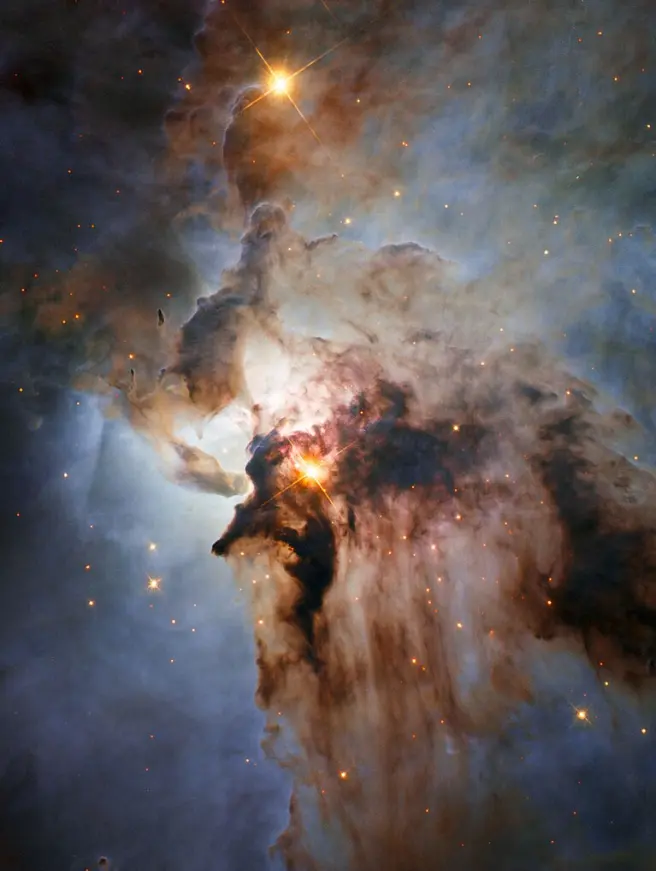
This NASA/ESA Hubble Space Telescope image shows the Lagoon Nebula, an object with a deceptively tranquil name. The region is filled with intense winds from hot stars, churning funnels of gas, and energetic star formation, all embedded within an intricate haze of gas and pitch-dark dust. Image: NASA, ESA, J. Trauger (Jet Propulson Laboratory) (CC BY 4.0)
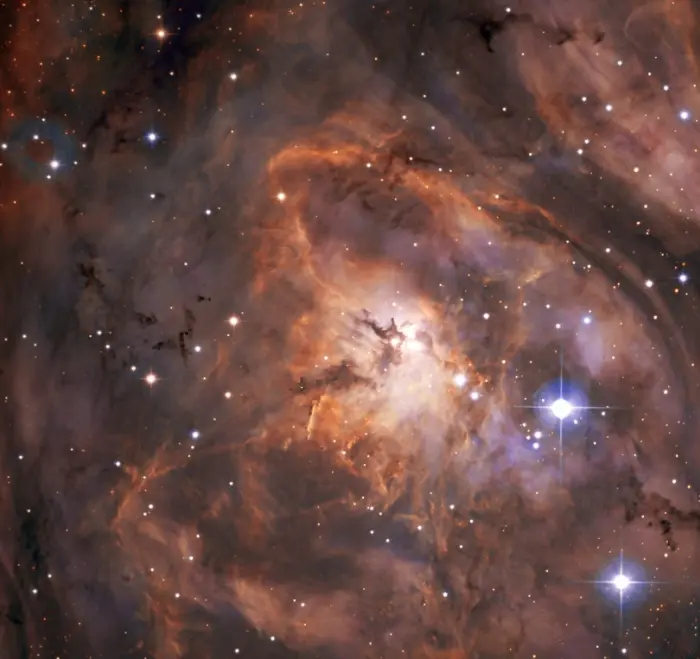
The Lagoon Nebula imaged from the SPECULOOS Southern Observatory. Credit: ESO (CC BY 4.0)
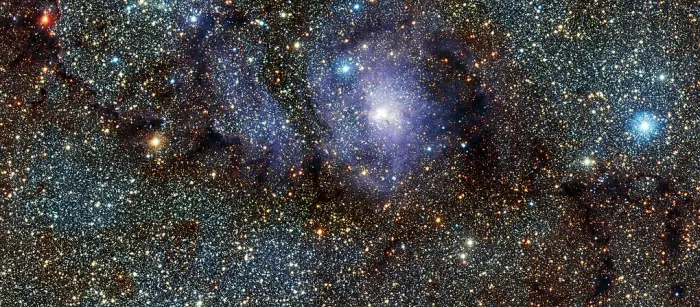
This infrared view of the star formation region Messier 8, often called the Lagoon Nebula, was captured by the VISTA telescope at ESO’s Paranal Observatory in Chile. This colour picture was created from images taken through J, H and Ks near-infrared filters, and which were acquired as part of a huge survey of the central parts of the Milky Way. The field of view is about 34 by 15 arcminutes. Image credit: ESO/VVV (CC BY 4.0)
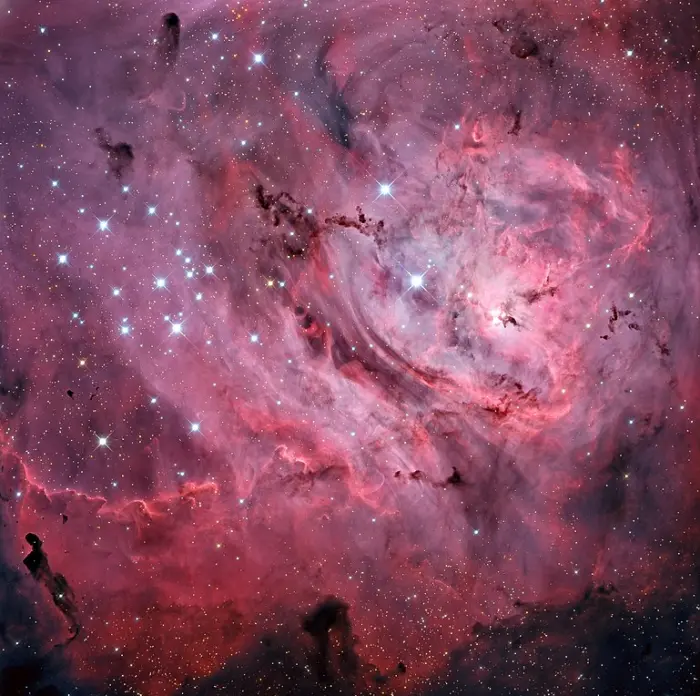
Lagoon Nebula in Sagittarius, image: Adam Block (CC BY-SA 4.0)
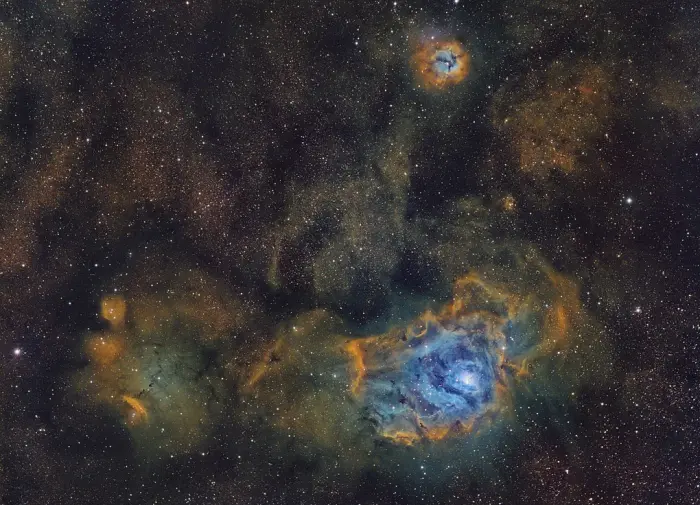
In this image of the Lagoon and Trifid Nebulae, the object is represented in a different light as opposed to the earlier true colour image. Instead of the usual RGB method of obtaining true colours of deep sky objects, the image featured here is an emission-line filtered image which represents the nebula’s chemical composition. In this case, the nebula is photographed using a modified version of what is known as the Hubble palette, in which three filters to isolate Sulfur, Hydrogen and Oxygen emissions are used. The data from these three filters are then mapped to Red, Green and Blue respectively to create a false colour composite as depicted above. Due to the overwhelming presence of hydrogen in the Universe, most of the objects photographed using this palette will therefore appear predominantly green, a contrast from the usual strongly red colours that ionized hydrogen emits when photographed in natural colour. Image credit: Wikimedia Commons/Ivan Bok (CC BY 4.0)
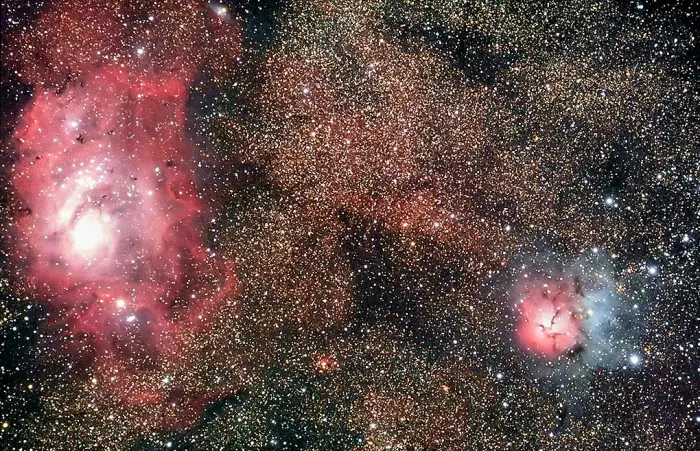
Messier 8 and Messier 20, image: Giuseppe Donatiello (CC0 1.0)
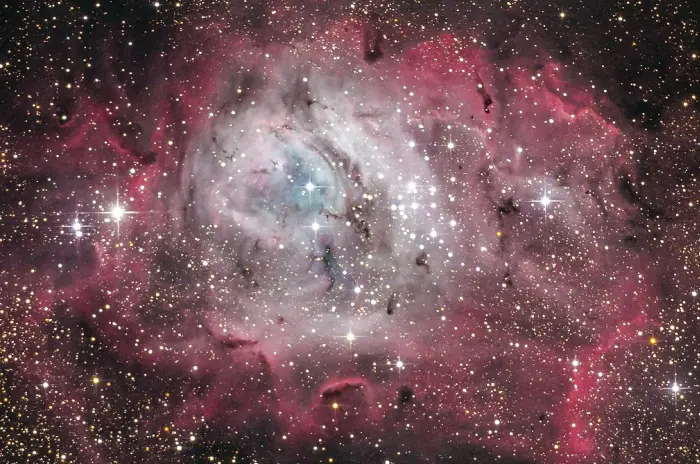
Lagoon Nebula, image: Wikimedia Commons/JU. Köhler (CC BY-SA 4.0)
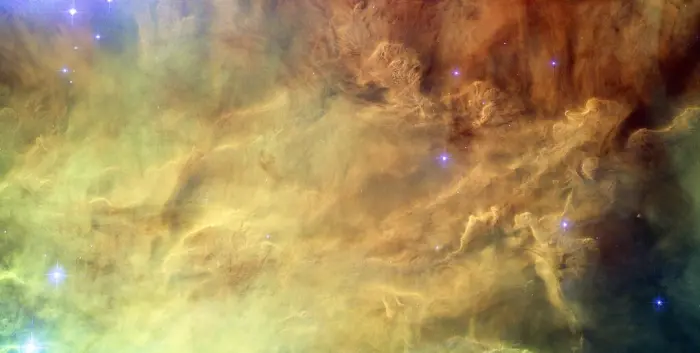
This close-up shot of the centre of the Lagoon Nebula (Messier 8) clearly shows the delicate structures formed when the powerful radiation of young stars interacts with the hydrogen cloud they formed from. This image was created from exposures taken with the Wide Field Channel of the Advanced Camera for Surveys on Hubble. Light from glowing hydrogen (through the F658N filter) is coloured red. Light from ionised nitrogen (through the F660N filter) is coloured green and light through a yellow filter (F550M) is coloured blue. The exposure times through each filter are 1560 s, 1600 s and 400 s respectively. The blue-white flare at the upper-left of the image is scattered light from a bright star just outside the field of view. The field of view is about 3.3 by 1.7 arcminutes. Image credit: ESA, NASA (CC BY 3.0)
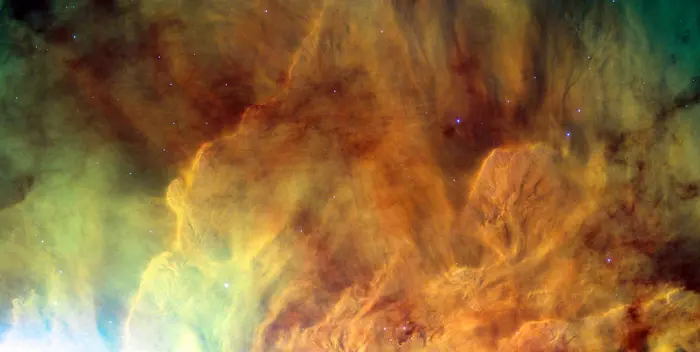
Like a Dali masterpiece, this image of Messier 8 from the NASA/ESA Hubble Space Telescope is both intensely colourful and distinctly surreal. Located in the constellation of Sagittarius (The Archer), this giant cloud of glowing interstellar gas is a stellar nursery that is also known as the Lagoon Nebula. Although the name definitely suits the beauty of this object, “lagoon” does suggest tranquillity and there is nothing placid about the high-energy radiation causing these intricate clouds to glow. The massive stars hiding within the heart of the nebula give off enormous amounts of ultraviolet radiation, ionising the gas and causing it to shine colourfully, as well as sculpting the surrounding nebula into strange shapes. The result is an object around four to five thousand light-years away which, on a clear night, is faintly visible to the naked eye. Since it was first recorded back in the 1747 this object has been photographed and analysed at many different wavelengths. By using infrared detectors it is possible to delve into the centre of these dusty regions to study the objects within. However, while this optical image, taken with the Advanced Camera for Surveys (ACS) on the Hubble Space Telescope, cannot pierce the obscuring matter it is undoubtedly one of the most visually impressive. Image credit: ESA/Hubble & NASA (CC BY 3.0)
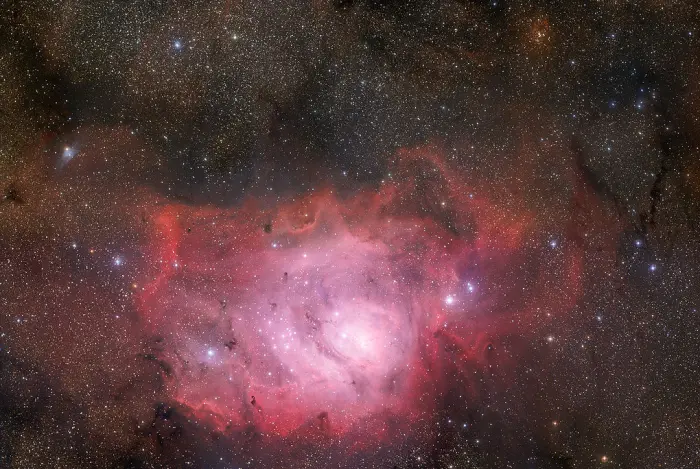
An amazing vista of the Lagoon Nebula taken with the 67-million-pixel Wide Field Imager attached to the MPG/ESO 2.2-metre telescope at the La Silla Observatory in Chile. The image covers more than one and a half square degree— an area eight times larger than that of the full Moon — with a total of about 370 million pixels. It is based on images acquired using three different broadband filters (B, V, R) and one narrow-band filter (H-alpha). Image: ESO/S. Guisard (CC BY 4.0)